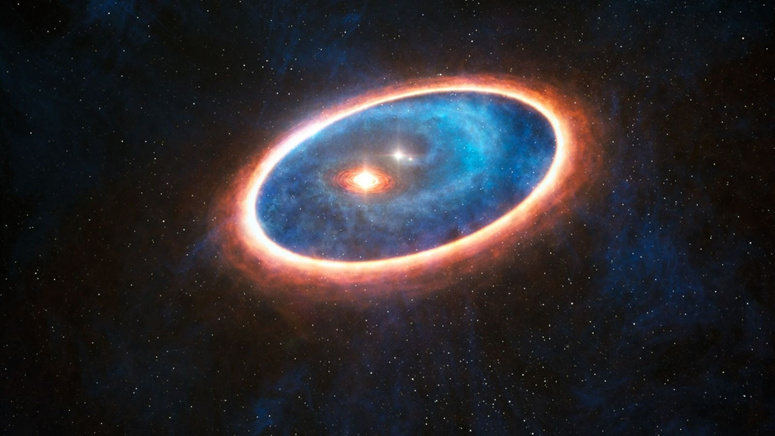A planet with three suns in full formation in the constellation of Taurus

The GG Tau A triple star system, pictured here, is surrounded by a large ring that powers an inner disk revolving around the star. This outer ring could well house a planet.
The rare and complex phenomenon, which is occurring in the GG Tauri A system, 450 light years from us, could help us better understand the formation of planets from binary systems in our galaxy.
Like a classical binary system, two of the three stars in this subsystem orbit tightly around each other. What is more unusual, however, is that this pair of stars orbit together around the third member of the group, creating a turbulent environment in which it is very unlikely to see planets forming.
Yet this is exactly what astronomers have found.
A world with three suns seems unimaginable: the shadows would naturally be tripled, the suns would continually eclipse each other, the sunrises and sunsets would be spectacularly variable. Although we do not yet know of such "circumtriple" planets, for some years some observations suggest that a planet may well be forming around the three stars of GG Tau A.
These same observations indicate that at some point deep in the system, a sort of gaseous conveyor belt would provide the essential ingredients for planetary formation.
"If all goes well, in a few million years we could have a circumtriple planet and a circumstellar planet in the same system," astronomer William Welsh of San Diego State University revealed in 2014. who was not involved in the sightings mentioned above. “This system would be out of the ordinary. »
Astronomers have been observing the GG Tau A subsystem for decades. In 1993, a large dusty ring was detected around the trio (although scientists did not yet know it was a trio). Made up of diffuse gas and dust, the ring itself is about 90 times wider than an astronomical unit, ie the distance between the Earth and the Sun ; and its inner edge begins about 190 astronomical units from the central stars of the system.
The presence of this ring is not surprising, but observations from the European Southern Observatory's Atacama Large Millimeter/Submillimeter Antenna Array have revealed "puzzling" condensation near the outer edge of the latter, which the scientists immediately suspected it to be a young planet.
"The point we are observing could indicate the presence of a buried planet", explained in 2014 the astronomer Anne Dutrey, director of research at the National Center for Scientific Research (CNRS), who published her observations with her colleagues in the Nature magazine in October of that same year.

The discovery of planets around GG Tau A was not the main objective of the analytical work of Dutrey and his colleagues. The team initially hoped to understand the longevity of such a disk located deep within the system and made up of the materials needed to build planets. This disc, which swirls around the loneliest star of the trio, dubbed GG Tau Aa, is about 15 astronomical units wide. Generally, as in our solar system , planets condense inside these disks and form on a scale of millions of years.
In a close binary system, however, the longevity of these disks is not great enough to allow the formation of planets, because the latter are inevitably sucked up by their parent star in just a few thousand years.
Now, according to Dutrey, GG Tau A is about a million years old, and the disc is still there. How does he manage to survive in such an unfavorable environment for his existence?
With her colleagues, the researcher discovered that a current of gas linked the outer ring of the system to its inner disc. Material appears to be pouring in from the outer reservoir and replenishing the disk around the solitary GG Tau Aa, a process that could keep it alive long enough to (perhaps) allow new planets to form.
The team's observations are important for understanding how planets form in complex systems, but also for understanding the current count of planets in the galaxy, Welsh continues. Several planets with two suns have since been discovered, thanks in particular to the astronomer's work with NASA's Kepler space telescope .
“A very large proportion of stars are born in binary systems,” Welsh explains. “Thus, by better understanding the formation of planets in these binary systems, we can more accurately define the true number of planets that populate the galaxy. »
Source: websites

